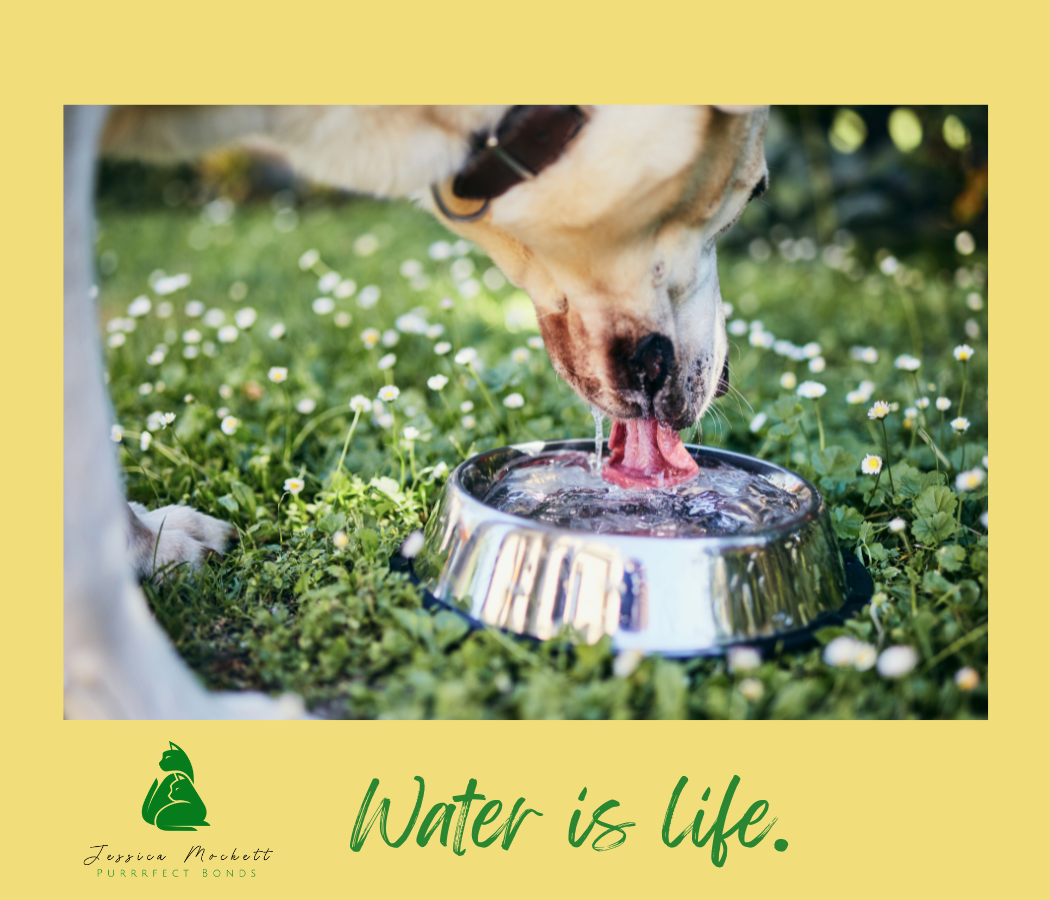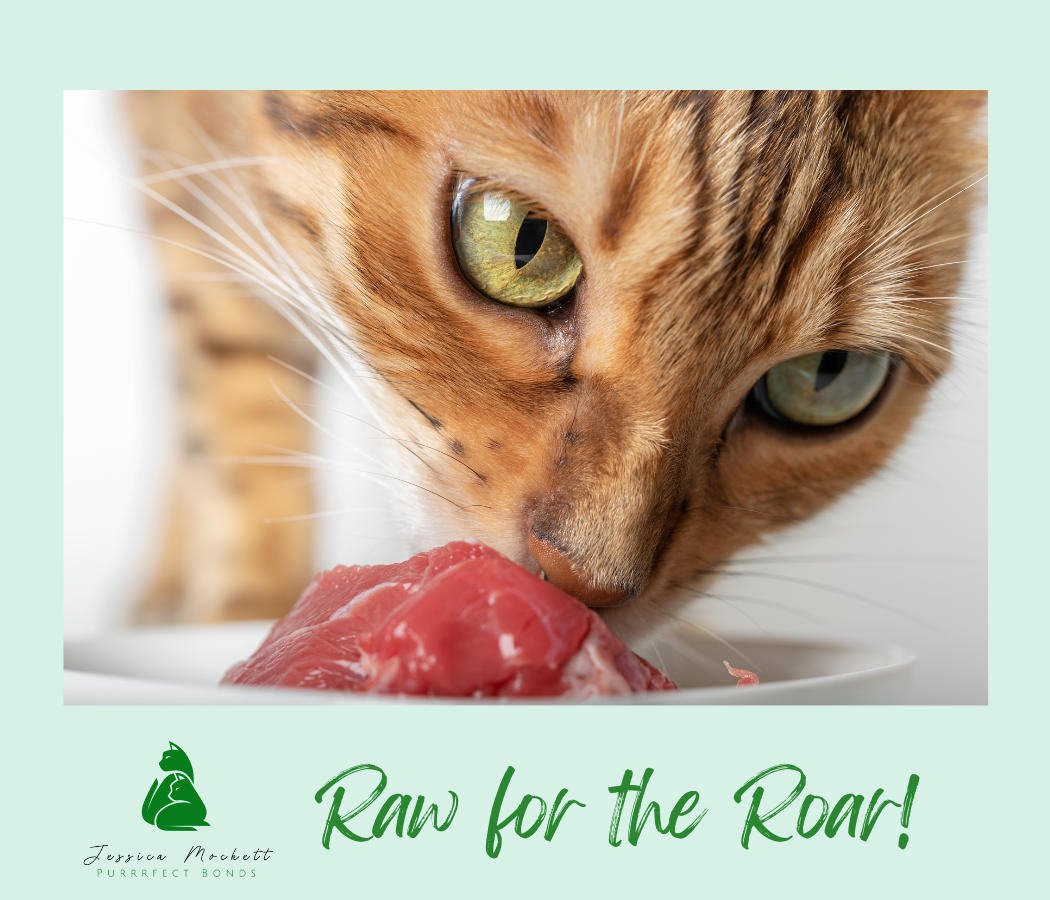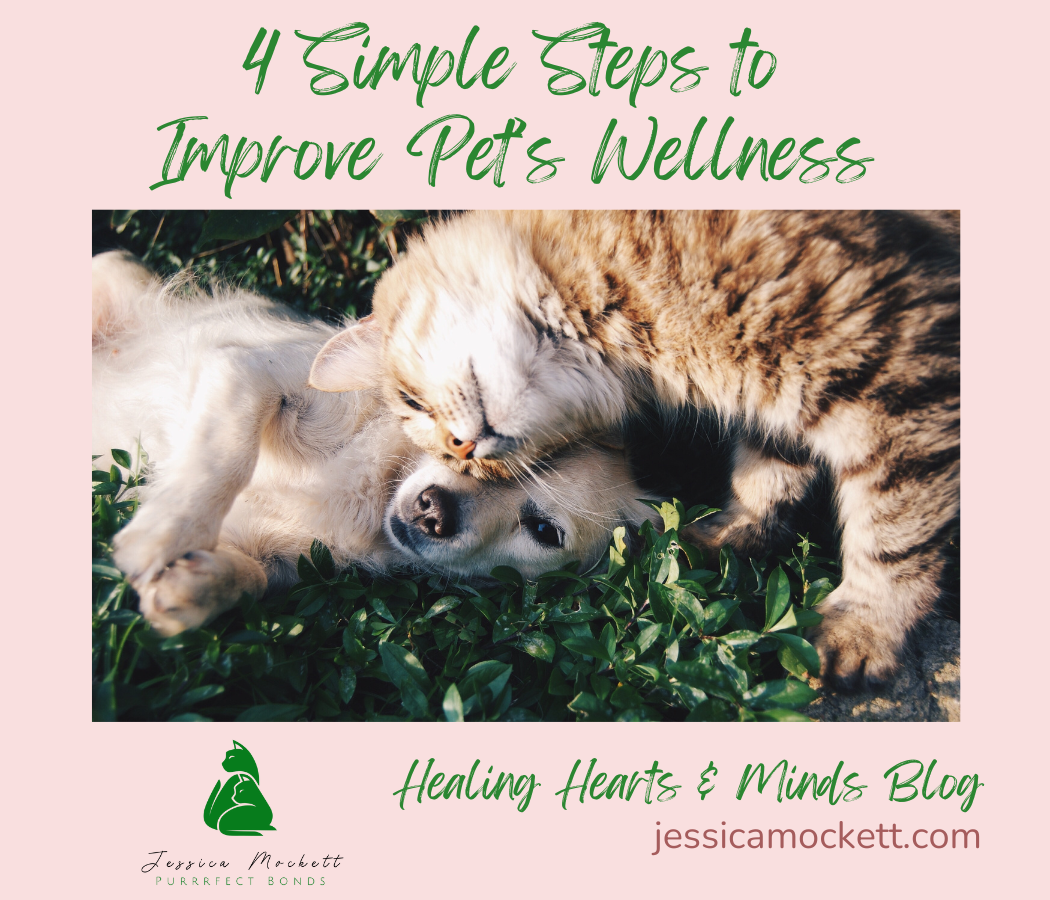We love our pets. However, we often don’t question the status quo of how to care for our pet’s wellness in our modern world. That status quo has a lot to do with commercial pet foods. We buy brands we see advertised and are most familiar with, thinking we are getting good food for our pets. But we really don’t know how to analyze the value of that nutrition.
What can we do to improve our pet’s wellness? Are there some simple things to understand and do to help our pet be healthier? Absolutely. Let’s read up on four ways we can make changes that will improve the wellness of our furry friends.

Water
Water is literally the foundation of all living things. Like our bodies, our pet’s bodies require a lot of water to maintain homeostasis within the body. In this post we aren’t going to address how to increase water for our pets but rather look at the quality of water we are giving to them. Tap water is often the main source of water that is given daily to pets. Now, the quality of tap water can vary not only from state to state but also from city to city. We can easily test our water by ordering a DIY test kit online, sending a sample to a lab, or reaching out the the water provider and asking for test analysis on water quality. Water filter salesmen also test the quality of our water, but sadly we can’t always trust that they will reveal the truth as they could profit by shocking us into buying their product. (I’m sure not all companies or sales folks are guilty of lying to us, but it is a possibility.)
Generally speaking, water that is between 50-300ppm is good/safe to drink. That means a certain percentage of the water contains traces of substances like minerals. I had my tap water tested a few years back and it was well over 900ppm.
Consider this when choosing what type of water to give pets.
- The smaller the animal the greater the impact of any contaminants in water.
- Water softeners can be a concern with adding too much salt into the animal’s system.
- Reverse Osmosis water can strip everything out to less than 50ppm, which means there are no trace minerals and animals do need some trace minerals. RO systems exist where they replace selected minerals which then makes it safer for pets to consume.
- Alkaline water usually has a pH of 8-9. Pets need water that is around a pH of 6-6.5. Alkaline water can produce an internal environment where crystals and urolith stones form in the bladder.
- Not all purified drinking water is the same. Some of these bottled waters are too acidic. We can test our favorite brands at home with a water test kit for pH.
- Spring water also varies in acidity and quality. Test these as well.
- Distilled water is devoid of minerals.
- Buying bottled water means buying plastic. Bottled water plastics should all be BPA free, but still for those concerned about the environment, it is challenging to go this route. We can try to offset by reducing the use of plastics elsewhere in our lives and by recycling.
My recommendation for improving our pet’s wellness is it’s good to have our bowls or fountains filled with different types of water, because giving our animal only a single source of water isn’t always ideal. In my home, we have a whole house filter that’s also softened with potassium chloride, one water bowl contains this option. I use purified drinking water in the fountains. I use spring water in the crystal gem pod water bowl.
Probiotics & Digestive Enzymes
Because most of our pets are on a commercial food diet or have been on one in the recent past, or they have had one or more rounds of antibiotics in their lives we should consider adding both probiotics and enzymes into their daily feeding routine.
Many veterinarians say probiotics have no real value because much of what we take, animals included, does not make it into the large intestine as the bacteria get destroyed before reaching that distance in the digestive tract. It is true that the deeper into the digestion tract probiotics go, the better. And there is really a variety in quality of probiotics and with pet specific probiotic brands. They often are not offering viable strains of good bacteria. However, when it comes to just saying it is all moot, I do not ascribe to that theory. It is important to do what we can to get good bacteria into the digestive tract. As such, many holistic veterinarians recommend that we give our dogs and cats a daily dose of probiotics. In particular, I recommend using quality human-grade, refrigerated probiotics. I personally use this one for my cats. I use a single capsule, once a day mixed in wet food for all six. Dogs over 50lbs can have a whole capsule. Pets in between 25lbs-50lbs get a half cap and kittens/puppies only a tiny sprinkle (less than 1/6 a cap).
Digestive enzymes help our pets to glean more nutrition from their foods by supporting the breakdown of food particles in the digestive tract. Enzymes help reduce vomiting/regurgitation and flatulence. There are many pet-product enzymes on the market, but a holistic vet that I follow, Essential Oil Vet, recommends this human-grade digestive enzyme capsule. Similar dosing as the probiotics, only verify with a holistic vet before giving to lactating pets and small kittens/puppies because it does contain essential oils. Give digestive enzymes with each meal.
Read Pet Food Ingredients
There is so much here to unpack. In an effort toward conciseness, many cheap ingredients are used in pet food. The biggest concern and the most frequently fed food is dry kibble. We should really only be using kibble as snacks and treats, if at all. Kibble is often made of very cheap and questionable ingredients and is intensely over cooked at high temps (to dry it) so that little flavor and nutrition is left. Which is why dry kibble is often rolled in oil and nutrients at the end of its production process. Canned wet food tends to have better protein content and substantially more moisture. There are some things to look out for here, too, but far less concerning than kibble on a whole. Highly processed at high heats, canning food damages nutrients. Companies exist that cook pet food at normal heats and “fresh” pack it for us (with a shorter shelf life). This usually provides better quality nutrition. Then there is raw food which really is the ideal, when done right, for both cats and dogs.
Here are a list of things to look out for in your pet foods:
- The AAFCO does not require cat and dog food nutrition labels to include the percentage of carbohydrates. It can be easy to look at the back and think – “Oh, no carbs! Great!” But it isn’t listed, ever. We have to do the work at this point to decipher about how much of the food contains carbohydrates.
- Cats really do not need carbs, anything more than 10% in their overall diet is too much. Dogs can consume a higher percentage of carbs and still do well, but still in moderation.
- Cats and dogs can technically eat and process carbs in foods, but what is the impact when the animal is getting 50% carbs in their kibble? Big pet food loves to tout that no studies prove that carbs cause health problems in our pets. But who pays for the studies that say there is no connection? As humans we’ve done some pretty weird and messed up things to the planet and animals in the name of profit. In short, carbs are cheaper than animal proteins, so pet food companies can make a better profit by filling foods with carbs.
- So how do we figure out carb content? Subtract the moisture content, redo the percentages on the other listings, add them up, and deduce carbs by what percentage is unaccounted for. For example: Kibble says 10% moisture, so your new total in now 90% not 100%. You divide the protein which is listed at 30% by 90% and the new total percentage is 33%. Do the same for each of the other line items. Add them up. Then subtract that new total from 100%. (There is “min” and “max” language, but we are not going to dive into that. It just means there is a small percentage of wiggle room on the macronutrients.)
- Most kibbles on the market are between 40-55% carbs. Most canned wet foods average between 10-20% carbs.
- Protein quality is important.
- A newer trend (trick?) to use plant protein as protein sources in pet food meant for carnivores is on the rise. The amino acids in these plant proteins are not the same as the amino acids in meat proteins, making it harder for the carnivore to convert them into usable material. Avoid foods that have things like pea or soy protein listed in the first 5-7 ingredients.
- There is not a way, based on the current labeling requirements, for us to differentiate what percentage of protein is coming from meats or plants. Ingredients are listed in order of the percentage of the whole with the highest percentage at the top of the list and so on. Look for foods with real meat listed in the first 2-3 ingredients.
- Also, understand that “meat meal” is very low quality protein. It is essentially a highly cooked/processed flour made from animal parts that are not qualified as meat. If your food only contains meat meals, it isn’t quality protein.
- Know that most commercial pet food companies use meats from sources deemed insufficient or unsafe for human consumption. There are some smaller pet food companies who use human-grade meats.
- Avoid these specific ingredients in pet foods if you are hoping to help your pet’s wellness:
- Carbs, but most especially from corn, soy, wheat (& gluten)
- Meat meals and veg protein (may see listed as “pea protein” or “soy protein”)
- Carrageenan (a thickening agent linked to causing cancer)
- Food colorings/dyes (totally unnecessary and typically only in cheap kibbles)
- High ash content or high percentages of phosphates, phosphorous, calcium (some is okay, too much is linked to health issues like urine crystals and stones)
It can feel overwhelming or challenging to change the foods we give our pets. But improving the nutrient quality and moisture content will be in the pet’s holistic health interest. It costs more to buy higher quality foods, but ultimately, it helps reduce our pet’s chances of contracting major diseases or having significant health problems.

Feeding Raw Food
I wish I knew about the benefits of feeding raw a long time ago. I’ve known for a few years how much it helps change a cat’s (or dog’s) life but the cost intimidated and worried me, so I didn’t make the switch. I already improved the quality of the commercial food I bought and switched to feeding more wet food than dry. It wasn’t until my vet said the words “stomach cancer” when I took my oldest cat Prim into him in March of this year that I thought I should try out raw food for reals. It wasn’t a definitive diagnosis, he just thought it a likely possibility as to why she projectile vomited so frequently. At the very least, I was dealing with some serious digestive tract issues.
In the months that Prim has been on 50% raw food, I have seen a dramatic decrease in vomiting. In fact the last few (which were weeks apart) were hairball related and not at all the massive, watery, projectile vomits I had been dealing with. She put on a bit of weight, which she needed. And I noted that the cats’ fur coats are shinier and softer.
This intro is to say, I get it. It can seem too much to go raw. It may not be affordable or you may have an immune compromised cat or dog. However, I am now convinced between my own personal experience feeding raw and from the raw transitions I helped clients with that raw food gives our carnivores the best chance at obtaining pet wellness. If your pet is still a puppy or kitten, start introducing raw now to make it easier.
If you want to go raw, please read this blog post. Send me a message or set and appointment and I will help you make the transition with your pets. Even just adding a percentage of raw will improve your pet’s holistic health. If you are ready now to dive into raw, for cat’s and smaller dogs I recommend Viva Raw. I’ve had a good experience with this brand so far. Use this link to buy at Viva and you get 20% off your first order and I get a little discount on my pet food, too.
I hope you are excited about these four simple steps that you can take to help improve your pet’s wellness!
If you want to read more from me on the care of cats, check out my books!




